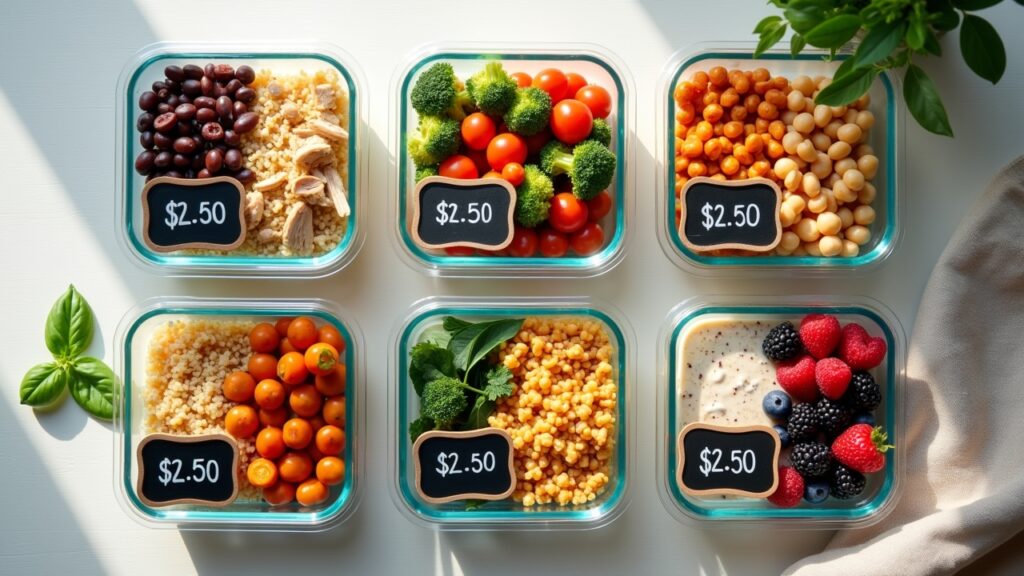Advertisements
Did you know the average American family spends over $10,000 on food each year? When I first saw that stat, I nearly choked on my coffee! Back when I started tracking our expenses, I discovered we were hemorrhaging money at the grocery store – and don’t even get me started on those sneaky takeout receipts.
Let me tell you, learning budget meal planning literally saved my sanity (and my wallet). It’s not just about pinching pennies though. It’s about eating well, reducing stress, and actually enjoying dinner time without that nagging guilt about overspending.
Why Budget Meal Planning Changed Everything for Me

I used to be that person wandering aimlessly through the grocery store at 5:30 PM, trying to figure out what to make for dinner. Sound familiar? Not only was it stressful, but I’d grab whatever looked good – hello, $8 pre-made salads and fancy cheeses!
Once I started planning meals on a budget, everything shifted. My grocery bills dropped by almost 40%. We stopped wasting food because everything had a purpose.
Plus, that daily “what’s for dinner?” panic? Gone. There’s something incredibly freeing about knowing exactly what you’re cooking each night.
My Simple Weekly Planning System
Every Sunday morning, I grab my coffee and spend about 20 minutes planning. I’ve tried fancy apps and complicated spreadsheets, but honestly? A simple notebook works best for me.
Here’s my process:
- Check what’s already in the pantry and fridge
- Look at the weekly grocery ads (I use the Flipp app for this)
- Plan meals around what’s on sale
- Write out a detailed shopping list organized by store sections
- Stick to the list (mostly – I’m human!)
The key is building meals around sale items. If chicken thighs are $0.99/pound, guess what we’re eating this week? I’ve gotten pretty creative with chicken over the years!
Money-Saving Strategies That Actually Work
Let me share some tricks that have made a huge difference. First up: buying in bulk isn’t always cheaper! I learned this the hard way when I bought a massive bag of quinoa that went bad before we could use it all.
Instead, I focus on these strategies:
- Cook once, eat twice (hello, leftovers for lunch!)
- Batch prep ingredients on Sundays
- Keep a price book to track best deals
- Shop my pantry first before making a list
- Use cheaper cuts of meat and slow cook them
My biggest game-changer? Learning to love beans and lentils. They’re crazy cheap, super filling, and way more versatile than I thought. My kids don’t even notice when I sneak lentils into the spaghetti sauce anymore!
The Freezer is Your Best Friend
Seriously, I cannot stress this enough. When ground beef goes on sale, I buy several pounds and freeze it in meal-sized portions. Same with bread, cheese, and even milk (yes, you can freeze milk!).
I also started making freezer meals on weekends. Spending a few hours prepping saves me both time and money during busy weeknights. Plus, having homemade “fast food” in the freezer prevents those expensive pizza deliveries.
Real Meal Ideas That Won’t Break the Bank

Here’s what a typical week looks like in my house:
- Monday: Slow cooker chicken and vegetables (costs about $8 for 6 servings)
- Tuesday: Bean and cheese quesadillas with homemade salsa ($5 total)
- Wednesday: Pasta with meat sauce using sales ground beef ($7)
- Thursday: Breakfast for dinner – pancakes and scrambled eggs ($4)
- Friday: Homemade pizza night ($6 for two large pizzas)
- Weekend: Leftovers remixed or a big pot of soup
None of these meals are fancy, but they’re satisfying and my family loves them. The best part? Our weekly grocery budget for a family of four is usually under $100.
Your Turn to Start Saving
Look, I’m not gonna lie – getting started with budget meal planning takes some effort. The first few weeks might feel overwhelming. But trust me, once you get into the rhythm, it becomes second nature.
Start small. Maybe just plan three dinners next week. Use what you already have. Don’t aim for perfection – aim for progress.
The money you’ll save can go towards things that really matter. For us, it meant finally taking that family vacation we’d been dreaming about. What could you do with an extra few hundred dollars each month?
Ready to transform your food budget and reduce mealtime stress? Dive deeper into money-saving strategies with more helpful tips at Cashflow Zen. Your wallet (and your family) will thank you!




[…] the best gift you can give yourself and your family is financial stability. Want more tips on managing your money throughout the year? Check out other helpful articles at Cashflow Zen – we’re all about […]